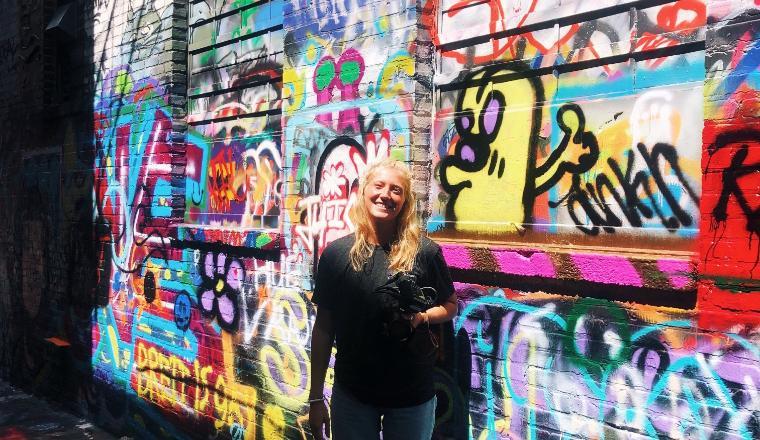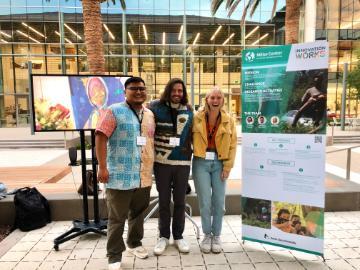
Baltimore Through a Lens
A Miller Center for Social Entrepreneurship fellowship gave Hannah Miller ’22 a unique opportunity to help share the stories of Baltimore-based social entrepreneurs determined to make lasting change in their communities.
The summer before her senior year, Hannah Miller '22 found herself zooming across Baltimore with a camera and notepad in hand, interviewing local entrepreneurs about their businesses. Chester France, owner of Lifting Labels, employs formerly incarcerated men and women who make ceremonial apparel, including clergy robes and university gowns. Kenya Miles owns Blue Light Junction, a natural dye studio, processing center, and an educational facility focused on the relationships between people and plants. Sabrina Thompson, of Launchpad, is bridging art with STEM.
When she first traveled to Baltimore, Miller had no idea what to expect. The native Bostonian had often heard of this major city in Maryland but had never been there before.
The month-long trip would turn out to be a life-changing journey that challenged Miller in unique ways and allowed her to immerse herself in a city rich in culture, history, and people pushing to improve their communities.
Miller, a communication major with minors in Spanish and entrepreneurship, worked with fellow seniors Nat Gilmore ’22 and Ángel Macías ’22 to enhance the marketing profile of the resource network Innovation Works, which aims to close the neighborhood and racial wealth divide in Baltimore by supporting small businesses and entrepreneurs.
Their goal was to improve Innovation Works’ messaging—meaning how it communicates its mission, resources, and values to the community—through storytelling. They conducted dozens of interviews, created a strategic communication plan, and filmed a short documentary about the network featuring several of its entrepreneurs. Hopefully, the content they created helps Innovation Works expand its reach to create sustainable change in Baltimore neighborhoods.
Innovation Works is a strategic partner of the Miller Center, which sends some of its fellows to Baltimore each year to support the network through needs-based research.

The experience allowed Miller to cross paths with community residents and small business owners that are an integral part of Baltimore’s cultural fabric. It also taught her about the importance of collaboration, she said.
“I couldn’t have done the fellowship without my amazing team,” says Miller. “Nat and Ángel were my rocks and the three of us, being strangers before, became absolute best friends. Each of us brought own our own part of our identity to the project. It wouldn’t have happened without each of us.”
In order to highlight the wealth divide in Baltimore, you have to understand the city. How did you go about doing that, knowing you only had a few months?
Nat is from Baltimore so we were fortunate to be able to live in his family’s home with his parents and siblings, which is kind of unconventional for the fellowship. It just worked out well. The three of us had never met each other before. Nat knew Baltimore but Ángel and I had never been there.
Baltimore is a city that kind of gets misunderstood by the public eye, which is sad because it’s an amazing city. It’s very divided because of years of historical trauma, segregation, and oppression. I think that when you come into Baltimore as an outsider, you definitely feel like an outsider because it’s a city with a really rich culture. There are many different identities within it. Figuring out how we fit into that was a complex and exciting process. Innovation Works was really there to ground us in learning about it. I think we just had to keep coming back to the fact that we were learning and experiencing Baltimore through the eyes of the amazing entrepreneurs that we were meeting, through this community and organization. In doing that, the people and the relationships we built and the beauty we got to see in Baltimore was absolutely incredible.
What was your role in the project?
Nat was very focused on the documentary side because he is a filmmaking extraordinaire, and Ángel was focused on the strategic communication plan with his background in political science and ethnic studies and interest in urban planning. I was jumping between both projects, which was a really interesting place to be. I loved the more creative sides of myself that I got to exercise with the filmmaking but also loved the research and analytical aspects that I got to do in the communication plan. It really showed me that you need both to create messaging and to create storytelling. My role was bridging the analytical and the creative.
Was there an entrepreneur who left a lasting impression on you?
There is one entrepreneur who I think of so frequently. Her name is Sabrina Thompson. For the documentary we interviewed around 10 entrepreneurs who are in the Innovation Works network. Sabrina is a NASA engineer, artist, atmospheric physicist and an author. She just got her master’s degree. She does it all and has worked relentlessly throughout her life to get to the remarkable place she’s in today. She started an organization called Launchpad, which is bringing the arts to young communities and students. Sabrina is teaching STEM through art. Her art is not only just incredible but also her drive and passion.
During our interviews for the documentary, I was helping out with the cameras but I was also the one asking the questions. I got to have all of these incredible conversations. My interview with Sabrina just really stuck with me. I remember so clearly, she said, “art is manifestation.” She wrote a book called Girl in Space about a young girl who wants to be an astronaut. But it’s really about women and girls taking up space and claiming our space in the world. She’s bridging all these crazy metaphors with art and STEM. The idea that you can be and make anything you want through art, as an artist myself, it stuck with me and I really look up to her.
You said you feel like people have certain misconceptions or preconceptions of Baltimore. How did you figure out how you wanted to portray the city in the documentary?
We struggled with this a lot because we never wanted to come in and be extractive or paint Baltimore in a certain light. We just really wanted to be a canvas for Innovation Works to share their story and for the entrepreneurs to share their stories. Before every interview we would tell people, “We are not here to tell your story, we just want to help you tell yours.” I think we struggled with that, though, because in any film or medium you inherently play a role in it because you’re behind the camera. There was our experience learning about Baltimore as people and then there was also our experience in Baltimore behind a camera. They’re often very different.
We wanted to be as much of a blank canvas as we could be for the story to create itself through their words. We just followed the story. That took us to such amazing places. For example, we kept hearing about this one entrepreneur in all of our conversations named Chester France. He started a business called Lifting Labels where he creates clerical robes, or liturgical robes by employing returning citizens—formerly incarcerated men and women—who help create them. It’s really cool. We kept hearing about him and were like, “Who is this Chester guy?” We ended up just reaching out to someone and being like, “We’d love to talk with Chester, can we head over to his office?” A lot of the entrepreneurs didn’t have offices that were up and running because of COVID. But Chester did. So we got to go and meet a lot of the people that work with him. It was just such an incredible interview, and it ended up being a really big part of the story. We learned about Baltimore by following the story and following the community.
What did you learn from your Miller Center fellowship?
I am really grateful to have had the opportunity. Before going into the fellowship, I really didn't know much of what I wanted to do with my last summer or my time at Santa Clara. I really wanted to get more involved with the community and I think the fellowship really gave me that opportunity to meet a lot more people and expand my horizons outside of Santa Clara. For a while I was feeling like, “Oh, you need to leave the U.S. to do that or you need to travel internationally.” But going to Baltimore showed me how much there is to learn at home. And I think that incorporating both domestic and international fellowships is really critical, but recognizing that they are different and being able to honor the difference between these types of opportunities is important. I think preparing students to enter into communities and how to best do that with intentionality and respect is so critical.
What do you hope people take away from the documentary that your group created for Innovation Works?
One of the Innovation Works employees described it as a love letter to Baltimore. That was so moving when she said that. I think that that’s how we want people to feel, like it’s a love letter to Baltimore for people who were in it and also for people who watch it. Ultimately, we want people to watch it and be like, “I want to get involved with that organization.” But I think we just really want to bring light to the beauty that we witnessed in the people and the place of Baltimore.
For more information, email Hannah Miller.
Miller Center fellow, Hannah Miller '22, pictured in Baltimore in August 2021.